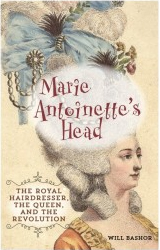Before Marie Antoinette’s famous date with the guillotine in 1793, her head was the envy of French society, thanks to hairdresser Leonard Autié.
Were those 30-pound elaborate wigs part of the frivolity and follies that would help make her the last queen of France?
Leonard Autié is the subject of a new book by alum Harold “Will” Bashor ’00M, who earned an M.A. in French from the College of Arts & Sciences at Ohio University, followed by a Ph.D. in International Relations and Diplomacy from the American Graduate School in Paris. Bashor teaches at Franklin University in Columbus and is a member of the Society for French Historical Studies.
Marie Antoinette’s Head: The Royal Hairdresser, the Queen, and the Revolution tells the story of Autié, who was not only Marie Antoinette’s hairdresser but also her confidant. He was the man responsible for the style that made her the envy of France and partly for the uproar that dragged her to the guillotine. The book was named a New York Post “must read” and awarded the Adele Mellen Prize for Distinguished Scholarship.
“Marie Antoinette may have worn the French crown, but only Leonard Autie reigned over the queen’s crowning glory. Now, historian Bashor chronicles the escapades of the hairdresser to the queen of France. Autie invented the elaborate pouf hairstyle associated with the decadence of Versailles. As the only man allowed to live among the women of the French court, his own life was filled with sex and intrigue,” writes New York Post reviewer Biller Heller.
The following Q&A with the author is excerpted from Bashor’s website.
Marie Antoinette’s Head is pitched as “The Devil Wears Prada comes to Versailles.” Can you explain why?
Sure. Besides his proximity to the queen, Leonard also had a most fascinating life filled with seduction (he was the only man in a female dominated court), intrigue, espionage, theft, exile, treason, and possibly, execution. The French press reported that Léonard was convicted of treason and executed in Paris in 1794. However, it was also recorded that Léonard, after receiving a pension from the new King Louis XVIII, died in Paris in March 1820. Granted, Leonard was known as the magician of Marie-Antoinette’s court, but how was it possible that he managed to die twice?
What inspired you to write Léonard’s story?
I was spending an afternoon at the Carnavalet Museum, a collection strong on the history of Paris and the French Revolution and housed in a Renaissance-era mansion, when I came across a lock of Marie Antoinette’s hair. I remembered that she almost fainted at the sight of the red-hooded executioner in her prison cell that cold morning, and she recoiled with horror when he asked her to turn around so he could cut her hair, necessary to ensure that the guillotine’s blade would work properly. Her hair. It was the talk of all Europe when she held her elaborate court at Versailles. But it would be the last thing to go, and here was a lock of it. I was spellbound.
Queen Marie Antoinette was loved and hated. Should she be despised or pitied?
When the princess arrived in France, she had no idea that she would become one of the best-beloved, the best-hated, and the most miserable women of her time. First known for her dignity and grace, later her faults and follies would help fuel the fires of a revolution that would make her the last queen of France. Whether despised or pitied, Queen Marie Antoinette remains, after more than two hundred years, one of the most fascinating characters in history.
“For this book I have nothing but praise. The book is so well researched, so well written, so totally readable that it will appeal to a very wide public….” writes David Wingeate Pike, a professor at the American Graduate School in Paris.
Mark Dubovec of the Grove City Record interviewed Bashor:
“This hairdresser was pretty uncanny,” Bashor said. “He had a lot of tricks up his sleeve.”
Bashor said Autie started out as a provincial barber in the south of France, fashioning the hairstyles of actresses, before moving on to work for nobility.
He was a man driven to achieve fame and fortune.
Wigs weighing up to 30 pounds, featuring elaborate scenes such as miniature naval battles, were hallmarks of his ostentatious stylings.
“He was someone who came from nowhere,” Bashor said. “He really worked his way up, becoming wealthy until the Revolution. Then he lost everything…. It’s kind of tragic.”
Initially, Bashor said, Autie’s work with Marie Antoinette in developing her style made her the envy of French society. But by the time of the Revolution, her elaborate hairstyles he fashioned became associated with the scorned decadence of the French aristocracy.
“When the Revolution comes and he’s had this friendship with the queen, his head is at risk, too,” Bashor said.




















Comments